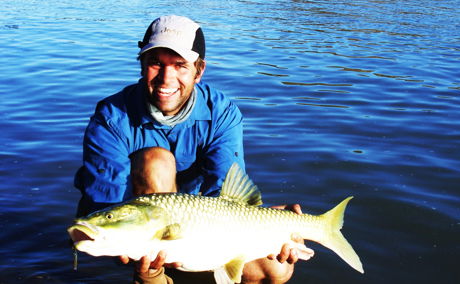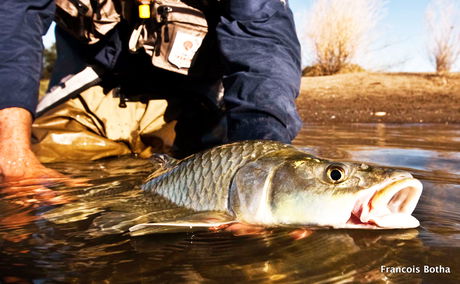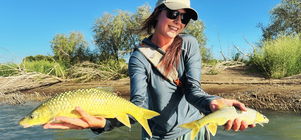Are you planning a fishing trip to Africa? Which species should you be scouting for?
How to differentiate between smallmouth and largemouth yellowfish?
It is clear from several studies that largemouth yellowfish and smallmouth yellowfish are morphologically distinct and identifiable using several features, amongst others mouth position, mouth size, eye to preopercular groove distance, colouration, interorbital width and eye position in general. Having fished and guided on the Orange River system for the past 25 years I have observed many of these differences and can give some practical pointers.
The following publications are some of the best resources to really have a scientific analysis of the key differences and were used in this article:
- Skelton, P. 2001. Freshwater Fishes of Southern Africa. Struik Publishers, Cape Town
- Morphological variation in Orange River Yellowfishes (Cyprinidae: Labeobarbus) Roger Bills, Martin Villet and Nick Jones
1. Colouration
In general, largemouth yellowfish has a more silver appearance and smallmouth a more yellow olive colour. This, however, is not a rule and sometimes the colour looks quite similar.
 Cameron Anderson with a nice example of a silver coloured largemouth yellowfish.
Cameron Anderson with a nice example of a silver coloured largemouth yellowfish.
 Klaas Viljoen with an example of a yellow/olive coloured largemouth yellowfish.
Klaas Viljoen with an example of a yellow/olive coloured largemouth yellowfish.
 A very pretty silver coloured smallmouth yellowfish.
A very pretty silver coloured smallmouth yellowfish.
 The author with a good "normal" coloured smallmouth yellowfish.
The author with a good "normal" coloured smallmouth yellowfish.
2. Body form and fins
Largemouth and smallmouth yellowfish share plenty of genes and DNA studies show that they probably have a common ancestor. Bills, Villet and Jones found that smallmouth yellowfish samples from the lower Orange River differ greatly in depth and fin size.
 A photo of one of the samples taken at Aliwal North on the Orange River of a smallmouth yellowfish by Bills, Villet and Jones
A photo of one of the samples taken at Aliwal North on the Orange River of a smallmouth yellowfish by Bills, Villet and Jones
 A photo of a sample smallmouth yellowfish from the Orange River at Pella that clearly show much longer fins and a deeper body, also from the Bills, Villet and Jones
A photo of a sample smallmouth yellowfish from the Orange River at Pella that clearly show much longer fins and a deeper body, also from the Bills, Villet and Jones
In general, largemouth has a slightly different shape than smallmouth, but to exclusively use this as an indicator can be misleading.
 A drawing from Skelton 2001 that shows the general appearance and shape of a typical smallmouth yellowfish.
A drawing from Skelton 2001 that shows the general appearance and shape of a typical smallmouth yellowfish.
 Drawing from Skelton 2001, that shows the general appearance and shape of a typical largemouth yellowfish.
Drawing from Skelton 2001, that shows the general appearance and shape of a typical largemouth yellowfish.
3. Mouth
The unmistakable shape and size of the mouth of a largemouth yellowfish is normally a great way of distinguishing between the two species, but unfortunately, some smallmouth yellows have very largemouth like shaped mouths. Smallmouth yellowfish has some very interesting evolutionary features; their mouth can evolve from a rubber lipped mouth to a very largemouth like mouth in a couple of years! This obviously complicates matters.
 This picture is a good example of the shape and size of the mouth of a good largemouth yellowfish.
This picture is a good example of the shape and size of the mouth of a good largemouth yellowfish.
It seems that most scientists agree that the bottom jaw is a great indicator, as largemouth yellowfish has a much longer lower jaw than smallmouth yellowfish. From photos, it is difficult to determine the exact posterior articulation point, but on the water, it is really easy to see, you literally just take the lower part of the mouth and move it, the jaw movement will clearly show the point. This is one of the features that apparently does not overlap between the two species.
 This figure from the Bills, Villet and Jones study clearly shows the difference between the lower jaw of the two species.
This figure from the Bills, Villet and Jones study clearly shows the difference between the lower jaw of the two species.
4. Eye position
Largemouth yellowfish often hunt prey in front and probably above them, while smallmouth mostly feed on prey lower in the water column. According to Bills, Villet and Jones, this is probably the reason that smallmouth yellowfish has greater interorbital widths than largemouth yellowfish.
 This figure from the Bills, Villet and Jones study shows the difference between the interorbital width of the two species.
This figure from the Bills, Villet and Jones study shows the difference between the interorbital width of the two species.
The eyes of smallmouth yellowfish are also normally visible from the bottom of the fish; in other words, if you look at the fish from its belly, you should be able to see the eyes of a smallmouth and not that of the largemouth yellowfish. Unfortunately, this seems not to be true for all smallmouth yellowfish but is, in general, a good indicator.
 These two pictures clearly show the difference between the eye position of the two species.
These two pictures clearly show the difference between the eye position of the two species.
5. Preopercular groove
The distance from the posterior orbit to the preopercular groove is greater with the more predatory largemouth yellowfish than with smallmouth yellowfish. This seems to be the most reliable test according to Prof. Skelton.
 These two photos clearly show that the distance between the preopercular groove and the posterior orbit is much larger in largemouth than with smallmouth yellowfish.
These two photos clearly show that the distance between the preopercular groove and the posterior orbit is much larger in largemouth than with smallmouth yellowfish.
Prof. Skelton recommends the following test:
Measure the distance between the preopercular groove and the middle of the eye(x) and then the distance between the middle of the eye and the tip of the nose(y). If X is greater than y, it is a largemouth yellowfish, and if y is greater than x, it is a smallmouth yellowfish. This test is apparently very close to 100% accurate on fish larger than 100mm. But according to Bills, Villet and Jones eye size can influence snout length and the distance between the eye and preopercular groove that could influence this test in smaller fish.
 From the two photos above, the test as described by Prof Skelton is quite clear.
From the two photos above, the test as described by Prof Skelton is quite clear.
I adapted the test a bit to make it easier to differentiate between the two species by using the properties the scientists use, as in some instances the results of the test show that X and Y are very close to the same distance. I take the same measurement for X as per the above test, but use the corner of the mouth(even if it is not that easy to get a precise location) as Y. from this test, x and y for smallmouth yellowfish is very similar(although not always in the same way as the mouthpieces of the fish often differs) and with largemouth yellowfish X is always much longer than Y. This test I have found also helps with smaller fish.
 The two photos above show the authors variation on the Skelton test.
The two photos above show the authors variation on the Skelton test.
Hybrids
The question arises if hybrids between the species do exist. Mills, Villet and Jones did not find any such evidence in their study, but could not rule it out. From DNA tests they found similar genes, but tests were inconclusive. They did not, however, rule out the possibility of hybrids. Some scientists also agree that hybrids could exist. There are certainly fish that has similar attributes, whether this is due to a common ancestor or hybridisation is not clear, but in some instances, the lines are a bit blurred.
From my research, the jaw length, eye position and the preopercular groove to eye distance test seem to be the most accurate, but a combination of all these features would make things easier in practice.
Further Reading
A film depicting the fly-fishing on the Orange River at Gkhui Gkhui River Lodge
A look at why Gkhui Gkhui River Lodge is a great destination to get the hobby of partner fishing going!
























Share This Post